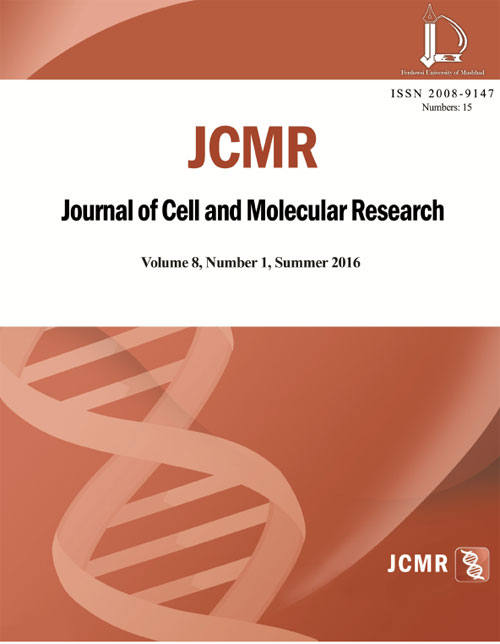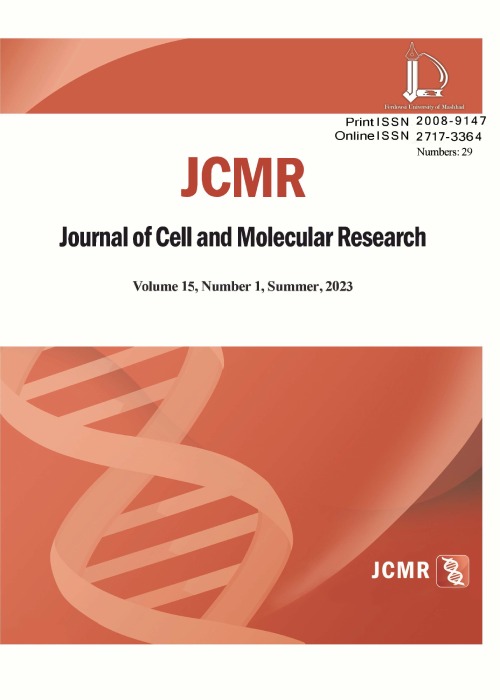فهرست مطالب

Journal of Cell and Molecular Research
Volume:8 Issue: 1, Summer and Autumn 2016
- تاریخ انتشار: 1395/02/20
- تعداد عناوین: 7
-
-
Pages 1-7Keratinocyte Growth Factor (KGF) is a paracrine-acting and epithelium-specific growth factor produced by cells of mesenchymal origin. Based on preclinical data, recombinant KGF plays a critical role in protecting and repairing of damaged epithelial tissues. Despite great efforts to express recombinant human KG (rhKGF) in different organisms, attempts for finding appropriate protein expression system with the ability of producing a properly folded and processed KGF needs further investigation. Pichia pastoris has been used successfully and extensively for production of industrial enzymes and pharmaceutical proteins. Herein, we investigated the affect of pro-region-α-factor early deletion on production and secretion of rhKGF in Pichia pastoris. Initially, expression of human KGF induced in MCF-7 cell line treated with 1, 25-Dihydroxy vitamin D3. The coding sequence of full length rhKGF194 was then cloned into the yeast integrative expression vector, downstream of α-factor and was integrated into P. pastoris genome. KGF protein was expressed in P. pastoris x33 cells, usingα-factor signal peptide for translocation of KGF to ER. An internal human signal peptide was also arranged after α-factorfor early removal of the pro-region in ER. RT-PCR results demonstrated that KGF mRNA was expressed successfully after induction by methanol. Recombinant KGF protein expression was detected by Western blotting in cell lysats, but not in conditioned media. A molecular weight of 17 kD for rhKGF194 indicates that the α-factor and internal human signal peptideshad been removed in x33 cells. The results indicate that in the absence of pro-region-α-factor, the recombinant KGF protein was not efficiently processed and transported within the biosynthesis-secretory pathway. As KGF protein is an unstable growth factor and tend to aggregate because of some native properties, It seems that presence of a chaperon molecule fusion with KGF is necessary for efficient secretion of the recombinant protein.Keywords: Keratinocyte growth factor, Pichiapastoris, Signal peptide
-
Pages 8-14Variegation in flower color is commonly observed in many plant species and also occurs on petunia (Petunia hybrida) as an ornamental plant. Variegated plants are highly valuable in the floricultural market. To gain a global perspective on genes differentially expressed in variegated petunia flowers, we investigated the expression of chalcone synthase (chs) and chalcone isomerase (chi) as two essential genes in biosynthesis pathway of pigment production. Also, we measured the concentration level of total flavonoids, naringenin chalcone and naringenin to evaluate the probably relationship between the expression profile of chs and chi genes and the concentration of mentioned pigments. The results indicated that chalcone synthase and chalcone isomerase expression had different profile in different petal color of Petunia hybrida. Because red flower color in petunia is related to the synthesis of pelargonidin-based (orange to red) pigments, our results suggest that the low chalcone synthase and chalcone isomerase expression levels in white petals reduce dihydrokaempferol formation, thereby inhibiting pelargonidinproduction. In contrast, the high expression levels of these genes observed in red petals ensure sufficient anthocyanin yields to make flowers red.Keywords: Real, time PCR, Chs, Chi, Petunia hybrida
-
Pages 15-24Multiple sclerosis is characterized by the loss of oligodendrocytes and demyelination of axons. In this study, the effect of caffeine on spatial memory in rats was investigated following demyelination induction by lysolecithin (LPC). The expression of Myelin Basic Protein (MBP), Glial Fibrillary Acidic Protein (GFAP), and Olig2 (oligodendrocyte lineage marker) genes was also assessed in the hippocampus. Animals were divided into seven groups; control group: animals received normal saline by stereotaxic intrahippocampal injection in Dentate Gyrus (DG) area; LPC group: animals received 2 μl lysolecithin by stereotaxic intrahippocampal injection in DG area (they were evaluated 7, 14, and 28 days after LPC injection; Caffeine- treated group: animals were treated with caffeine at doses of 30 mg/kg intraperitoneally for 7, 14, and 28 days after receiving LPC. Behavioral study was performed using Radial Arm Maze. Moreover, the RT- PCR was carried out for gene expression investigation. The demyelination and defective remyelination were noticeable on 28th day which suggests the demyelination decline caused by caffeine. Behavioral study showed that on the post-lesion days, the food finding time in the LPC group was significantly higher than that of the control group. Caffeine consumption significantly attenuated the food finding time in the treatment compared to the LPC group. The RT-PCR analysis indicated that the lysolecithin decreased the MBP expression especially on days 7 and 14 and conversely increased the Olig2 and GFAP expression. In addition, the caffeine enhanced the expression of MBP compared to that of the LPC group and reduced the Olig2 and GFAP expressions. Our results demonstrated that caffeine could increase the remyelination process in hippocampus and improve the spatial memory following demyelination induction by the LPC.Keywords: Demyelination, Remyelination, Lysolecithin, Hippocampus, Caffeine
-
Pages 25-34Steroid hormones in plasma play an important role in reproductive cycles of animals especially during the final maturation stages. Steroid hormones synchronize gonad developments depending to fish species reproductive strategies. The wild Cyprinid fish, Kutum (Rutilus frisii kutum) is an ecologically and economically important fish species which inhabit in southern coastline of the Caspian Sea in Iran. Over the past few decades, natural reproduction of this species dramatically impaired due to the urbanization, civilization close to the land and shallow water in south western of the Caspian Sea. Therefore annual sex steroid hormones and gonads development were measured to assess the annual reproductive biology of female Kutum. In this study for the first time, our aims were to determine the annual variations in sex steroid hormones; 17 β Estradiol (E2), Progesterone (P) and testosterone (T) and gonad development of female Kutum. Our results showed that plasma steroid levels in females manifested in two phases in annual reproductive cycle; the resting phase (June - February) being characterized with the lowest level of steroid hormones and the peak reproduction activity phase (MarchMay) with simultaneously a significant increase in level of E2, P and T in plasma. Interestingly, comparing with other Teleost fish species the baseline level of E2 in plasma of Kutum during the resting phase to some extent was also huge. Increase in concentration of plasma E2 was in accordance with an increase of gonadosomatic index during spawning season. Our results contribute to our knowledge about the reproductive biology of Kutum and calls further long-term investigation.Keywords: Sex steroid profile, Gonad development, Female Kutum
-
Pages 35-36Yellow corky vein is a prevalent disease among navel oranges in the Fars province of Iran. Previously we showed that a variant of Hop stunt viroid (HSVd-sycv) was associated with the disease. It was closely related to citrus variant of HSVd from Japan (HSVd-cit8) and with 93.7% homology with lime yellow corky vein variant of HSVd (HSVd lycv). In this study, putative RFLP (Restriction Fragment Length Polymorphism) analysis using Vector NTI program (version 9.0.0) showed that some restriction enzymes could cut HSVd-sycv but not HSVd-lycv. On the other hand, M.Ngo BIX and FauI which could cut HSVd-lycv at positions of nt 53 and 97, respectively, could not cut HSVdsycv. Likewise, some restriction enzymes could cut HSVd-cit8 but could not cut HSVd-sycv. Therefore these variants can be recognized by these restriction enzymes.Keywords: HSVd, sycv, HSVd, lycv, Restriction Fragment Length Polymorphism analysis
-
Pages 37-38Cancer is a multi-factorial disease that is spreading very fast in today's world. Informative activities and preventive efforts have been increased in recent years. Conventional therapies are used for patients to reach an acceptable level of success and patients can continue their lives but there are some side effects and most of the times the normal cells encounter damages by these therapies and also probability of recurrence always exist. So, the presence of a definitive therapy is needed to cure patients without these problems after therapy. Cancer cells need to use specific molecules in their cellular networks to continue their lives. Therefore, by elucidation of these molecules and targeting them purposefully a therapeutic strategy can be developed that is called targeted cancer therapy.Keywords: Targeted cancer therapy, Multi, factorial disease, Specific molecules, Signaling network
-
Pages 39-45Diabetes is one of the alarming health problem in Pakistan. According to international diabetes federation (IDF), about 7 million Pakistanis are victims of diabetes accounting a total of 3% population. Most of Pakistanis still prefer to use herbal medicines for almost all of their health issues. Aegle marmelos (commonly known as the bael tree) is highly reputed ayurvedic medicinal tree as it has been used in traditional medicine for centuries. In this pre-clinical work, 32 mice were induced for diabetes via injecting alloxan intraperitoneally at a dose of 100 mg/kg body weight and mice having 104-170 mg/dl sugar level were considered diabetic. All mice were divided into two groups, each group with three sub-groups containing normal, control and diabetic mice. One group was given normal feed whereas other group was given a food containing Aegle marmelos leaf extract at 300 mg/kg body weight as an effective dose against alloxan induced hyperglycemia. The experiments lasted for 60 days and blood samples (05 ml to 1.0 ml) were collected from coccygeal vein of rats on 1st day, 30th day and 60th day of the experiment in heparinized tubes and blood glucose level was measured using spectrophotometer by enzymatic kit at a wavelength of 540nm. It was observed that the Aegle marmelos leaf extract is an effective herbal remedy in reducing and maintaining the glucose level in normal and hyperglycemic miceKeywords: Diabetes mellitus, Aegle marmelos leaf, Hyperglycemia, Pre, clinical study


